Playing the Guitar with Triads Chords
I believe that the following web pages contain the world’s fastest, most novel, advanced, easiest, and fun system ever devised for learning to play guitar triads. This system reduces the time to learn to slowly play songs using triad chords in any musical key from about two months to approximately four hours. The four hours consists of an hour to read the part of this website on triads, an hour to mark the guitar, and two hours of spaced-out practice. And, you can never forget what you learned here because it is all marked on your guitar with removable colored dots.
Almost everyone learns to play guitar using open chords (sometimes called cowboy, country, or campfire chords). These chords use only the first three frets which are the closest frets to the nut of the guitar. This allows you to not press some string or strings with your fingers and it still sounds correct. There is no movement of the left hand up and down the fretboard with open chords. For this reason, you can play most of these open chords with your eyes closed.
For example, on a G major chord, you strum the guitar and hear six notes but you had to finger only three notes. The extra three notes are just repeats, but an octave higher. This open chord method works so well, that most beginning guitar players never hear of triad chords. I got my first guitar when I was 14 years old and heard about triads when 86 years old!

The shape of our three major triad chords.
What are triad chords? Major chords are made up of only three notes. For example, a G major chord consists of G, B, and D notes. Triads chords also have only three notes and are usually played on the upper three thinnest and highest sounding strings of the guitar, but any adjacent three strings can be used. The big problem is, in triads the chords are scattered all over the length of the fretboard and you have to visually hunt for them.
For example, all four of the triad chords of D, E, F, and G have the same shape, but they are each in different positions up or down the fretboard. One would think that technically learning to play on just three strings is much easier that playing on six strings. But mentally using just three strings with chords scattered the length of the fretboard is more difficult and confusing.
To play in triads here is what you need to learn:
- the fretboard position and shape of 8 major three-string chords
- the fretboard position and shape of 7 minor three-string chords
- the fretboard position and shape of seven 7th shaped three-string chords,
and - how to play by ear the chords of the #1, #4, #5 progression in all seven
musical keys. Most players using other methods never learn to play in all
seven keys. We even teach you how to play in the additional five half-step
keys of Db, Eb, Gb, Ab, and Bb. As far as we know, this is the first memory
system ever devised to teach all whole and half step keys. And - the root, the 3rd, and the 5th finger position of the seven major triad chords.
The above list tells you why it takes two months to learn triads by other methods. We can teach you the contents of the above list in less than an hour, and you can’t forget it if your guitar is nearby. We accomplish this enormous memory feat by using modern teaching and learning theory. Everything in these web pages pertaining to teaching and learning and memory theory with be written in this purple color so you don’t confuse it with music theory. Here are some learning theories we use to learn triads. The conscious mind can only handle well one task at a time, but the subconscious mind can handle several tasks simultaneously, such as your breathing, sitting, moving your strumming hand, and picking the chords. We will teach you to program your subconscious mind (“muscle memory”) with repetition, so the conscious mind is freed to make decisions and remember. We will use color-coding to learn all of the chords, and will use the memory of shapes rather than using letters or words.You will be shocked by how fast you learn with our teaching method.
So that you can now hear the beauty of triad chords, I’ll will play a guitar using a progression of open chords, and then by using a looper recorder, I’ll multi-track some triad chords on top of the open chords. These two types of chords are beautiful when played together.
Video of Duet of Triad chords and open chords
If you have always played guitar using only open chords on the first three frets, there is nothing that will add more to your musical sound than learning triad chords.
Here are 9 things that learning triads will bring to your music:
- Triads are significantly higher in pitch than open chords. The triad sound pierces through the sound of a band and is heard well.
- Triads teach you the location of the harmonizing notes are in the middle of the fretboard which enables you to easily back-up singers and instruments.
- Triads sound especially beautiful when played on an electric guitar as a duet with an acoustic guitar.
- Triads enhance the sound of any song.
- You will be learning to play nearly any song in any key in a different and higher pitched way.
- Triads allow you to finger pick easily because you are using only three strings.
- ll triad chords are slidable up or down which closely mimics the steel guitar sound. Especially use it in county music.
- Triad chords are on the fretboard in alphabetical order, left to right.
Here is the color I assign to each of the notes and chords of the major scale. It is wise to learn this list before proceeding (you are learning here by association).
A = Apples = Red
E = Every color = white
B = Blue
F = Fudge = Brown
C = Citrus fruit = Yellow
G = Green
D = Dark = black
In order that you do not have the remember the location and fingering of the seven major chords needed for playing in triads, I’m asking you to mark them on your guitar with easily removable colored dots held by Scotch tape. To do this you make the colored dots using a hole punch on the proper colors in the newspaper. You stick the colored side of the dots on the sticky side of clear Scotch tape and cut the Scotch tape so that only about an eighth of an inch extends beyond the dot. You then slide a dinner knife underneath the strings over a fret, touch the Scotch tape onto the edge of the dinner knife and pull the colored dot and its tape back to its position and stick it there. Then pull the knife away.Here is a picture of the fretboard after the guitar is marked. You can see at the left the D chord as three black dots forming a triangle shape.Next is the E chord as three white dots, then the F chord as three brown dots, and then the G chord as three green dots. All of these chords have the same triangular shape. There are also three yellow dots for the C chord which are superimposed with the four triangular chords. Since C is our most commonly used chord and it is the best key for playing the melody in the middle of the guitar, it is marked.


You might notice that the A and B chords are not shown on the fretboard. They are located by colored dots marked on the side of the guitar neck. The picture on the right shows how each of the side dots on the neck represents on the fretboard an imagined Foot shaped chord, specifically, Green for G, red for A, Blue for B, and Yellow for C. This is seen best on my Master Memory Triad Playing Chart lower on this page. See the third chart of the three charts there. So, one of the biggest memory problems in learning triads is gone. You marked them on the guitar.
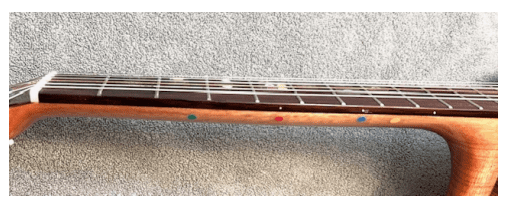
Seeing and learning the Major Triad chords marked on the guitar.
The first criterion for choosing a triad chord is that you must finger all three strings allowing you to slide that chord up and down the fretboard. We need to use only three such chord shapes or grips on the three upper, thinnest strings. They are the F, C, and D shapes in the right picture. (Notice for memory’s sake that the F shaped chord looks like a foot and Foot starts with the letter F, the dots of the C shaped chord is separated like the two ends of a letter C, and the D shaped chord is similar to a triangle in shape.)
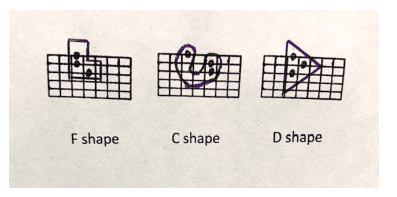
My Master Memory Triad Playing Chart
(You might be wondering as to how do we get the colored dots onto the guitar? That is described earlier (see the website Table of Contents for Attaching Color Markers to the Fretboard).
Note that we are calling this a Playing Chart, not a chord chart, because this unique chart tells and remembers for you about everything you need to know to play triads on the guitar, such as:
-
- the location on the fretboard of all seven of the major triad chords and shows a second location to play the C and G chords, our most frequently used triads.
- the location of three minor chords which tells how to locate all seven minor chords.
- the location of three seventh chords which tells how to locate all seven seventh chords, and
- the location of the #1, #4, and #5 chords for each of the seven major keys of music and an easy 10-minute method to remember it. See below for an explanation of the #1, #4, #5 progression. This chord progression is the key to playing triads by ear. This memory system which memorizes shapes will amaze you. Humans can learn shapes put together as a picture far better than learning a series of numbers or letters. These three charts will make it possible for you to play in all keys and even all half-step keys. Without our memory system it can take weeks, months or never to master this memory feat.
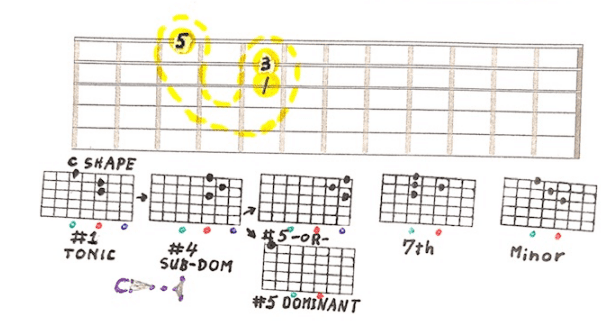
Let’s look now at where we are going to locate these three shapes to produce the seven chords (notes) of the major triad scale. The fretboard on the left shows the location of the yellow C chord. For the moment, disregard the six small chord boxes under the keyboard and disregard the numbers on the fretboard.
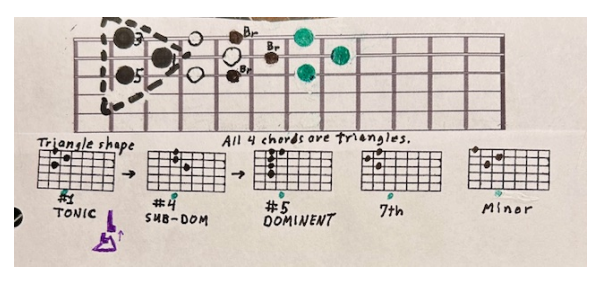
This second fretboard chart shows the locations of the chords for D (black), E (white), F(brown), and G (green). All have with the same triangular shape.
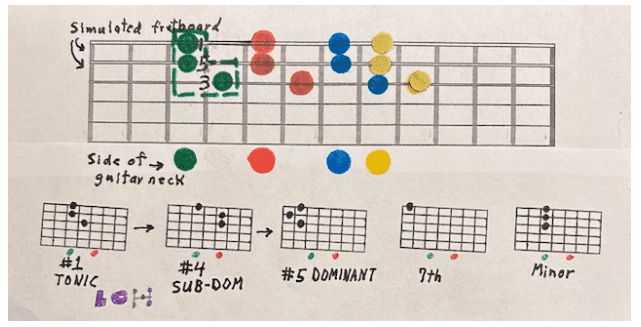
At this point you have seen My Master Memory Triad Playing Chart and perhaps have concluded that Triads are too complicated and would take months before you could play a song. So, let’s digress a moment and dispel your discouragement by having you play a song with triad chords in just five minutes from now
This third fretboard chart shows the location of the positioning dots on the side of the guitar which I have colorcoded going left to right for the keys of G (green), A (red), B (blue), and C (yellow). Each color-coded dot on the side of guitar neck corresponds to a color-coded foot-shaped chord on the fretboard chart. The foot-shaped key chords have been drawn onto this fretboard only for demonstration of the positions. They are not marked on the fretboard. While playing, these chords are only imagined in these positions using the dots on the neck as a guide as to where they are located. All four of these chords has the same foot shape.
There are three guitar fretboards drawn on my Master Memory Triad Chord Chart above. Go to the middle fretboard diagram. A “D” chord has dashes going around the D. Underneath the guitar neck diagram, you see another but smaller drawing of the D chord to the left in the line of five chord drawings. To the right of the D chord you see the two triad chords that are most often played with a D chord in nearly every song. These two chords are G and A7. Now pick or strum
this song.
D G D
On top of old Smokey, all covered with snow,
A7 D
I lost my true lover for courting too slow.
(Playing in triads can be that simple.)
VIDEO OF 'ON TOP OF OLD SMOKY' USING TRIAD CHORDS
Playing triads by ear:
When you are playing music by ear (without chord names or chord pictures), you need to know which basic chords (#1, #4, and #5) are used together in most songs. For example, in the key of C, the numbers of the notes of the scale (not pictured anywhere in this website) are C is (1), D (2), E (3), F (4), G (5), A (6), and B (7). The #1, #4, #5 progression is so common that each chord in it has been given a special name. The #1 chord is called the tonic, #4 is called the sub-dominant, and #5 is called the dominant. As an example, in the key of A, you just start at #1 which is the A chord marked on the fretboard (called the tonic), and count up the scale and find that #4 is D which is the sub-dominant, and #5 is E which is the dominant. With a little ear training, most guitar players soon learn the unique sound of the tonic, sub-dominant, and the dominant and can feel which of those is about to be used in the song.
On my Master Memory Triad Playing Chart you see the tonic, sub-dominant, and dominant chords for each key. These patterns can be very difficult to learn if you use the letter name of the chord because you have to find the position of that chord and recall the fingering. However, a memory trick using the chord shape, makes it easy. The explanation of this is lengthy here, but the execution when playing on the fretboard is instantaneous and works for all seven musical keys. This is best understood by hearing and seeing the #i, #4, #5 progression in a video.
(Video of #1, #4, #5 progressions in three different keys)

To understand this better, start with the C shaped chord (the top fretboard on my Master Memory Triad Playing Chart above). Look at the small purple drawing in the lower left corner of the C chart. It is reproduced above. With a little imagination you see (going left to right in the drawing) that the tonic chord, C, is depicted as a scoop of ice cream, then the sub-dominant chord is depicted as an ice cream cone which has sort of a triangular shape, then the dominant chord G7 is a choice of either a spot or three dots spread out vertically like a wall. To help remember the picture, you say: “An ice cream cone hits the spot or the wall”. The spot is the small bottom picture of the dominant chord that has only one fingered note. Remembering the small memory picture tells you the shape of the next chord in the progression, but where do you play that shape. Of the three helps you remember that the C is the most spread-out letter. It opens and has two ends. This also reminds you that the three chords in the C progression are the most separated of the three progressions used for playing by ear. The subdominant always goes higher in pitch (in this case only one fret), but the dominant goes down two frets which is a long way. Now you know the chords and where to play them. Crazy? Of course. But if you learn this little purple picture and its meaning, you can play rapidly in the key of C by ear without remembering any music theory.
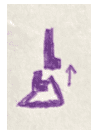
Go now to the triangular shaped chord chart (D) on the Master Memory Triad Playing Chart (the second fretboard). In the five smaller chord diagrams, the tonic (#1) chord looks a triangle. The sub-dominant (#4) looks like a shoe. The dominant (#5) looks a boot turned upside down. Now look at the small purple picture in the lower left corner of the chart which I have reproduced above. With imagination you see a triangular baseball home plate, and the catcher has a foot on the plate, and his boot is up in the air. What you say to yourself when you are playing in a key where the first note, (the tonic) is shaped like a triangle, meaning it is a D, E, F, or G) is that you are dealing with a baseball home plate. Going left to right, your sub dominant chord is shaped like a foot, and the dominant chord is like the catcher’s leg up in the air. Those are the shapes, but where do you play those shapes? A triangle is a very concentrated shape. It is the least spread out of these three shapes. The subdominant is always up the neck but it is touching the tonic. The dominant is always down or at the same place on the keyboard, so here with a compact triangle, the tonic is on the same fret. Crazy? Yes, but with that simple shape picture, you learned how to play triads in four different keys.

Go now to chart where the outlined tonic chord is G and shaped like a shoe. Now look at the purple memory drawing aid in the lower left corner and reproduced above. You see a Foot that is ready to kick the smashed “C” (so it looks like a football) through the goal-post, the right side of which is the three dot chord ending with a flat side like a goal-post. Your memory phrase is “the foot kicks the football (a smashed “C”) through the goal-post”. Now you know the shape of the tonic, sub-dominant, and dominant chords. How about their placement on the fretboard. The foot (G) is located by the green dot on the side of the guitar neck. The sub-dominate C shape is located with the marked yellow dots on the keyboard and as always is up the fretboard a bit, and the dominate is down the fretboard one fret, a moderate distance. Another crazy memory scheme! But if you learn it, you have just learned to play the #1, #4, #5 progression in four keys, G, A, B, and C. And since you are playing shapes, not the names or numbers of notes, you can just as easily play in half-step keys like E flat or B flat.
(Hint: if you have trouble remember my little memory pictures, print them, cut them out, and stick them on the fretboard near the hole of the guitar for a week. Now you have the whole system on your guitar.)
Playing the minor triad chords: The rule is, “to produce a minor chord, you lower the third of the chord by one fret.” What does that mean? Look at the top Master chart which features the C chord. You see the 1, 3, 5 numbers on the chord signifying the #1 (root), the third, and fifth note of the chord are counting up the scale. Look at the three numbers of the large C chord and then look at the small drawing of the minor chord just below the big fretboard. You see I have lowered the three position one fret toward the nut of the guitar, and that give the minor chord sound.
This is remembered because if you make one change to a 3 (the third) by rotating it slightly counter-clock wise, you get an M (for minor). The same process makes the minor chord in the triangle shaped and the foot shaped chords. For you to know the location of the root of the C chord and the triangle shaped on the fretboard, I have cut off part of the dot in the root position on the fretboard. For the C chord the 1 is on the lowest pitched string of the three, the 3 is on the middle string of the three, and the 5th is on the top string of the three. If you know the location of the 1, you know the 3 is on the next string up.
For the C chord the 1 is on the lowest pitched string of the three, the 3 is on the middle string of the three, and the 5th is on the top string of the three. If you know the location of the 1, you know the 3 is on the next string up.
On the triangle-shaped chords the 1 is on the tip of the arrow-head made by the chord so part of the dot is cut off in the 1 position. That means the 3rd is on the top string so that is the one you lower to make the minor chord. For the footshaped imagined chords, that leaves only the top string as the root of the footshaped imaged chords. On those chords, you lower the bottom string a fret to get the minor chord.
Playing the seventh triad chords: The rule is, “to produce a seventh (#7) chord you lower the pitch of the root (#1) of the chord by two frets”. The drawings in the Master chart show this for the C shaped and the triangle shaped chords. You remember this rule by knowing that to make a #7th, you do two things to a #1st. (see picture)
See how I have added two marks to a 1 to make a 7. However, for the foot-shaped chords it looks like there might be a drawing mistake. The root has been lowered by two frets, but the other two notes of the chord are missing (not fingered). This is because all seventh chords are actually made up of four notes, not three.To avoid a stretch of my fingers I used the other notes of the four here. If rarely you wanted to use the foot-shaped chord as a higher sounding key on the fretboard, the one fingered chord would not work. You would have to add a finger bar across the fret below the one-fingered chord.
More triad chords:
With time you may want to learn more triad chords mainly because the jump to the next chord is too far. Triad chords of any three adjacent strings are located all over the fretboard. Charts of triad chords including augmented and diminished chords are available from BestMusicStuff.com.
The right hand in playing triads:
Thus far we have written only about changes in the left hand when starting to play triads. A duet of a guitar played with strummed open chords and the other guitar with strummed triad chords sounds a bit muddy. Therefore, triad chords are usually picked with the fingers so their different rhythm and higher pitch is heard and appreciated. A straight pick also can be used to bring out the melody if you are playing the melody within the triad chords.
For players that have not done finger picking, it will take some practice to coordinate the left-hand fingering of chords with the right hand picking of strings. This will become automatic if placed into the subconscious mind by repetition. When playing a D or a G triad chord, you can occasionally add to your picking the G string of the guitar as an open string. It is part of a D and G chord. The video here shows several ways to pick the triad chords.
Video of right-hand picking
Video of Enhancements: the C chord, slides, and runs
Playing the melody: I do not generally use the triads to play the melody. I prefer to play the melody with the Simul chords (taught in a previous section of this website) and I play only in the keys of C and G, and then use a capo to move the melody to all keys.
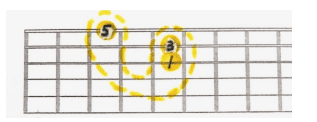
This way no new melody scales have to be learned with triads. Learning to play the melody in all keys is time consuming and difficult. An exception to my using Simal is sometimes I use the triad chord of C to play the melody because the C triad chord has its lowest note (the root of the chord) on the lowest of the three strings. It is best to have the root of the chord on the lowest string when playing the melody. With this location the musical scale goes up step by step. In our three triad grips of F, D, and C, only C has its lowest note on the lowest string. In each chord chart I put 1, 3, 5 on the left most demo chord to show where the first(root), the third, and the fifth of the pitch is located in that chord.
If you are going to play the melody along with some other notes from Simul or triad chords, the rule is, first learn to play the melody alone, and then add other notes.
Here is a video of a professional guitar player using only triads for playing “Only You”. Note that he uses a pick to bring out the melody while playing triads. I am playing the rhythm guitar with open chords and singing. Denny Scott is the owner and main teacher of Naples Park Music in Naples, Florida. He donated his time for this educational video.
Video of “Only You”.
Video of using triads as an intro from famous guitar players.
Practice: Hopefully, you now have much knowledge of triads in your conscious mind and/or labeled on your guitar. Some parts of that knowledge need to transferred to your subconscious mind through repetition (practice) and lots of it.
With practice you will soon not need to refer to the marking on the guitar except for long jumps on the fretboard.
Conclusion: You now have the world’s fastest, most novel, advanced, easiest, and fun system for learning to play guitar triads. Enjoy!
(If you have suggestions to improve these web pages, you can e-mail them to me
at JRKweb538@gmail.com.)
John Karickhoff, M.D.
© 2025